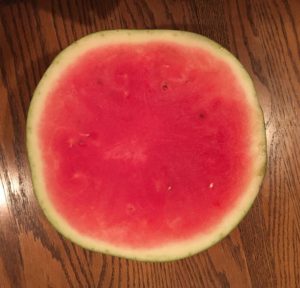Hello fellow readers, “Are seedless watermelon GMOs?” asked Lois from Tranquility, NJ. The consensus is they aren’t genetically modified, nor are they truly seedless.
Summer picnics bring back memories of seed spitting contests. Hard to do nowadays as most watermelons are seedless, though, in truth, it’s not so. Those little white thingies among the watery pink fruit are infertile seeds. True, they’re digestible. But so are the traditional black seeds if you’re so inclined. And both won’t cause a watermelon to grow inside your tummy. I still giggle over Mom’s warning, which backfired and inspired me to eat more seeds.
Designing seedless fruit has been in fashion for a very long time.
For over 2,000 years, seedless grapes have been made by rooting adult grape plant cuttings. Making seedless watermelon, which began in the ’90s, is a different process. Like horses mated with donkeys to make mules, seedless watermelons are hybrids – a mix of two species or varieties of plants or animals. Two mules cannot make more mules as they are sterile. The same is true of seedless watermelons.
The traditional watermelon has two sets of chromosomes. A chemical called cholchicine, derived from the autumn crocus plant, is used on seeds which causes the plant to grow four chromosome flowers—pollinating a four chromosome flower with a two chromosome flower results in an infertile watermelon with three chromosomes.
It sure sounds fishy; that changing the number of chromosomes isn’t genetically altering. But a GMOs use genetic engineering to change DNA. While a chemical derived from a plant is used to create a chromosomal change in the original seed, they don’t use genes from other organisms to modify a watermelon’s DNA.
The Oxymoron of Watermelon
So, how do you grow seedless watermelon if they have don’t have seeds that you can plant? It sounds like an oxymoron. (I love that word which means self-contradictory.) You’ll need to plant both four-chromosome seeds and two-chromosome seeds next to each other, so when they flower, they can cross-pollinate and produce watermelons with three chromosomes making them seedless.
It isn’t easy to explain, and I’m hardly an expert. I merely want to spit watermelon seeds; thank you very much. But I’ve outgrown the curiosity of what happens when you eat the seeds. Maturity sometimes changes the magic. Bittersweet (yes indeedy, an oxymoron).
Garden Dilemmas? AskMaryStone@gmail.com (and your favorite Podcast App.)
Column updated 11/20/21



